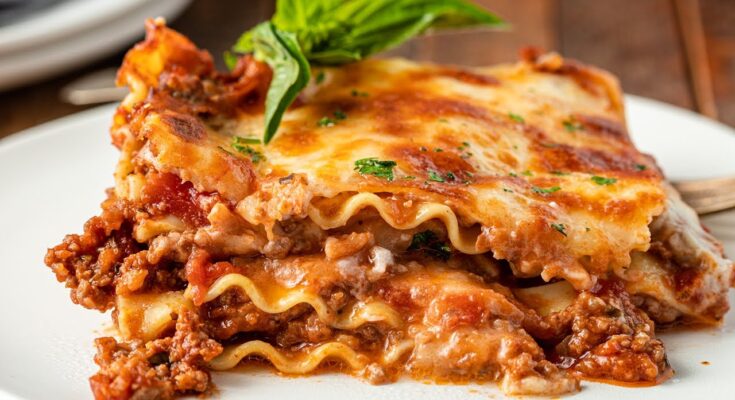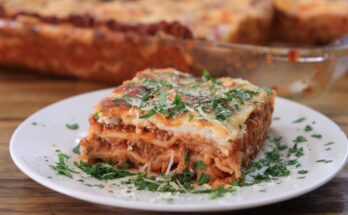White Lasagna Recipe: White lasagna, also known as “lasagna bianca,” is a luxurious twist on the traditional red-sauce lasagna. Instead of tomato-based sauce, it features a rich, creamy béchamel sauce layered with cheeses and various fillings such as spinach, mushrooms, or chicken. It offers a more delicate, cheesy flavor and is often considered a more elegant take on the classic comfort food. If you’re a fan of Alfredo pasta or creamy dishes, you’re going to fall in love with white lasagna.
Unlike the robust tang of tomato sauces, this lasagna leans into creamy textures and subtle, savory notes. You get the indulgence of melted cheese, the silky smoothness of béchamel, and the heartiness of noodles, all in one satisfying bite. It’s perfect for occasions when you want to impress your guests or simply treat your family to a comforting homemade meal.
Why You’ll Love This Recipe
This white lasagna recipe stands out for its simplicity, taste, and versatility. Whether you’re looking to make a cozy weeknight dinner or wow your guests at a dinner party, this dish is guaranteed to deliver. Here’s why it deserves a spot in your regular rotation:
- Rich and Creamy: The béchamel sauce adds a buttery, creamy texture that binds everything together.
- Customizable: You can keep it vegetarian or add proteins like chicken or shrimp for variety.
- Make-Ahead Friendly: You can prepare it in advance, making it ideal for meal planning or special occasions.
- Kid-Approved: With all that cheese and cream, it’s a surefire hit even with picky eaters.
Let’s get into the ingredients you’ll need to bring this delicious dish to life.
Ingredients You’ll Need
For the White Sauce (Béchamel)
The white sauce, or béchamel, is the soul of white lasagna. Here’s what you’ll need:
- 5 tablespoons unsalted butter
- 1/4 cup all-purpose flour
- 4 cups whole milk (warm)
- Salt and pepper to taste
- A pinch of ground nutmeg (optional but recommended)
- 1/2 cup grated Parmesan cheese
Béchamel sauce might sound fancy, but it’s actually quite easy to make. It provides that creamy, dreamy base layer that holds all the lasagna layers together.
For the Ricotta Filling
This filling adds texture and richness to the lasagna:
- 1 1/2 cups ricotta cheese
- 1 large egg
- 1/2 cup grated Parmesan cheese
- 1/4 teaspoon salt
- Freshly cracked black pepper
- Optional: 1 cup chopped spinach or sautéed mushrooms
Combining ricotta with an egg and cheese creates a luscious mixture that adds structure and depth to each bite.
Other Key Ingredients
You’ll also need the following for layering and baking:
- 9 lasagna noodles (no-boil or regular, depending on your preference)
- 2 cups shredded mozzarella cheese
- 1/2 cup grated Parmesan for topping
- Optional: 2 cups cooked, shredded chicken or vegetables
Now that your ingredients are ready, let’s move on to the cooking process!
Step-by-Step Instructions to Make White Lasagna
Step 1: Preparing the White Sauce
Start by making the béchamel sauce. Melt the butter in a large saucepan over medium heat. Once it’s completely melted, add the flour and whisk continuously for about 2 minutes to create a roux. The mixture should turn slightly golden but not brown.
Slowly pour in the warm milk, whisking constantly to avoid lumps. Cook this mixture for about 6-8 minutes, stirring often, until it thickens to the consistency of heavy cream. Season with salt, pepper, and a pinch of nutmeg. Stir in the Parmesan cheese and set the sauce aside. This silky sauce will serve as the base for every creamy layer of your lasagna.
Step 2: Making the Ricotta Filling
While the béchamel sauce is cooling slightly, it’s time to prepare your creamy ricotta filling. In a large mixing bowl, combine the ricotta cheese, one egg, grated Parmesan, salt, and a good pinch of black pepper. Mix everything until it’s smooth and well combined. If you’re incorporating spinach or mushrooms, make sure they’re fully cooked and well-drained before folding them into the mixture.
This ricotta filling is the secret ingredient that gives your lasagna its creamy richness and a slightly tangy contrast to the béchamel. The egg helps bind everything together so that the lasagna slices hold their shape when cut. If you like a little garlic flavor, you can also add a teaspoon of minced garlic or garlic powder for an extra punch.
This mixture should be smooth but thick—if it feels too dense, you can loosen it up slightly with a tablespoon or two of milk. Set it aside while you prep your noodles and other components.
Step 3: Cooking the Noodles
If you’re using no-boil lasagna noodles, congratulations—you can skip this step! But if you’re using traditional pasta, bring a large pot of salted water to a boil. Add your lasagna noodles and cook them until they’re just al dente. Overcooking will cause them to fall apart during baking.
Once cooked, drain the noodles and lay them flat on a clean kitchen towel or parchment paper to prevent sticking. Don’t stack them or they might turn into a gooey mess. You want your noodles to be tender but firm enough to hold the layers together without turning mushy.
Pro tip: Drizzle a tiny bit of olive oil over the noodles to keep them from drying out or sticking to each other while you assemble the lasagna.
Step 4: Assembling the Lasagna
Now comes the fun part—putting it all together! Grab a 9×13 inch baking dish and follow these steps:
- Start with Sauce: Spread a generous layer of béchamel sauce on the bottom of the dish.
- Add Noodles: Lay down your first layer of noodles. Trim if needed to fit the dish.
- Layer Filling: Spoon and spread a layer of the ricotta mixture evenly over the noodles.
- More Sauce: Drizzle a bit more béchamel over the ricotta layer.
- Cheese Time: Sprinkle a handful of mozzarella cheese over the top.
- Repeat: Continue layering—noodles, ricotta, béchamel, mozzarella—until you’ve used up all your ingredients.
- Top it Off: Finish with a final layer of noodles, topped with béchamel and a generous amount of mozzarella and Parmesan.
Make sure to press down lightly on each layer to compact the ingredients slightly. This ensures a dense, hearty bite in every forkful and keeps the layers from slipping apart when you serve it.
Step 5: Baking the Lasagna to Perfection
Preheat your oven to 375°F (190°C). Cover the lasagna with foil—tent it slightly so the cheese doesn’t stick to the top. Bake it covered for 25 minutes to allow all the layers to heat and set.
Then, remove the foil and bake for another 15-20 minutes, or until the cheese on top is golden and bubbling. If you like a little crisp on the edges, broil it for the last 2-3 minutes—just keep a close eye to avoid burning.
Once out of the oven, let the lasagna sit for at least 10-15 minutes before cutting. This resting time is crucial—it allows the layers to firm up so you get beautiful slices instead of a cheesy puddle.
Pro Tips for the Perfect White Lasagna
Want to take your lasagna from great to unforgettable? Try these expert tips:
- Use High-Quality Cheese: Splurge on good-quality mozzarella and Parmesan. It makes a huge difference.
- Season Every Layer: Taste and season each component as you go to avoid bland layers.
- Don’t Skip the Resting Time: Letting the lasagna sit after baking helps it set up properly for serving.
- Layer Strategically: Keep your sauce layers thin but even to ensure every bite is flavorful.
- Add Herbs: Fresh thyme, parsley, or basil sprinkled between layers add brightness.
Variations and Customizations
Vegetarian Version
White lasagna is inherently a great choice for vegetarians, especially when you skip meat-based fillings. The creamy béchamel and cheesy ricotta layers offer more than enough indulgence without needing meat. But if you want to up the veggie game, you’ve got tons of options.
Consider sautéed mushrooms, caramelized onions, baby spinach, or even roasted butternut squash. These ingredients add both flavor and nutritional value. Just make sure your vegetables are cooked and drained well—excess moisture can make the lasagna watery. Layering roasted zucchini or eggplant also adds an amazing texture and an earthy flavor that perfectly complements the creamy sauce.
This variation is perfect for Meatless Mondays or anyone trying to reduce meat consumption without sacrificing taste and satisfaction.
Add Chicken or Seafood
If you’re looking to add a protein boost, white lasagna pairs wonderfully with tender shredded chicken or delicate seafood like shrimp or crab. Cook the chicken in advance, shred it, and layer it in with your ricotta or between the béchamel layers. It adds heartiness without overpowering the creamy flavors.
For seafood lovers, go with cooked shrimp, crab, or even scallops. These lighter proteins blend seamlessly with the richness of the sauce and cheeses. Just be cautious with quantity—too much seafood can overpower the balance of the dish and introduce extra water content if not properly drained.
Adding protein turns this dish into a full-on main course fit for special occasions or holiday dinners.
Gluten-Free Options
Going gluten-free? No problem. There are excellent gluten-free lasagna noodles available in most grocery stores. You can also make a gluten-free béchamel by swapping out the all-purpose flour with gluten-free flour blends or even cornstarch.
For a lower-carb version, you could use thin slices of zucchini or eggplant in place of noodles. Just make sure to salt and drain them to remove excess moisture. This approach not only makes the dish gluten-free but also adds a fresh, garden-fresh twist to the creamy classic.
So, whether you’re following a special diet or just want to switch things up, there’s a white lasagna variation to fit your needs.
Serving Suggestions
White lasagna is incredibly rich and satisfying, so it pairs well with lighter side dishes that balance the creaminess. Here are a few delicious serving suggestions:
- Fresh Green Salad: A crisp salad with vinaigrette dressing helps cleanse the palate and adds a refreshing contrast.
- Garlic Bread: Because, let’s face it, more carbs = more comfort. Just keep the portion moderate.
- Roasted Veggies: Lightly roasted carrots, asparagus, or Brussels sprouts add a healthy and colorful side.
- Chilled White Wine: Pair your lasagna with a crisp white like Pinot Grigio or Chardonnay to cut through the richness.
For a dinner party, serve the lasagna family-style in the middle of the table with all the sides surrounding it. The beautiful golden top makes for an impressive centerpiece!
How to Store and Reheat Leftovers
One of the best things about white lasagna? It tastes even better the next day. Here’s how to keep it fresh:
- Storing: Let the lasagna cool completely before transferring it to an airtight container. It’ll stay good in the fridge for up to 4 days.
- Freezing: You can freeze individual portions or the whole dish. Wrap tightly in plastic wrap and foil to prevent freezer burn. It can last up to 3 months in the freezer.
- Reheating: For best results, reheat in the oven at 350°F (175°C) covered with foil until warmed through—about 25-30 minutes. For a quicker option, microwave individual slices for 2-3 minutes.
Pro tip: Add a splash of milk or cream when reheating to help revive that creamy texture.
Nutritional Information
Here’s a general breakdown of the nutritional profile per serving (based on 8 servings total). Keep in mind these numbers can vary based on the exact ingredients and portions:
| Nutrient | Amount (Approx.) |
|---|---|
| Calories | 450–550 kcal |
| Protein | 20–25 g |
| Carbohydrates | 30–40 g |
| Fat | 25–30 g |
| Fiber | 2–4 g |
| Sodium | 600–800 mg |
| Calcium | 25–30% DV |
While white lasagna isn’t exactly a “light” dish, it’s rich in protein and calcium, especially if you’re using whole milk, cheese, and added proteins like chicken. You can lighten it up by using part-skim ricotta and low-fat milk if desired.
FAQs About White Lasagna Recipe
What is white lasagna made of?
White lasagna, also known as white sauce lasagna or lasagna bianca, is made with layers of lasagna noodles, a creamy béchamel or Alfredo sauce, cheese (like ricotta, mozzarella, and Parmesan), and often includes chicken, spinach, or mushrooms.
Can I use store-bought Alfredo sauce for white lasagna?
Yes! Store-bought Alfredo sauce is a great shortcut. Just make sure it’s thick and flavorful, or enhance it with garlic, herbs, or a bit of cream.
Can I make white lasagna ahead of time?
Absolutely. You can assemble white lasagna a day ahead and refrigerate it. When ready to serve, bake it straight from the fridge—just add about 10–15 extra minutes to the baking time.
Can I freeze white lasagna?
Yes, white lasagna freezes well. Wrap it tightly in foil or plastic wrap, and freeze for up to 3 months. Thaw overnight in the fridge before reheating.
What meat goes best in white lasagna?
Shredded chicken, ground turkey, or even Italian sausage pairs well with the creamy white sauce. For a vegetarian option, use sautéed mushrooms or spinach.
Conclusion
White lasagna is the perfect answer when you crave something rich, creamy, and comforting but want a break from traditional red-sauce pasta dishes. With layers of cheesy goodness, a silky béchamel, and endless options for customization, this dish is a total showstopper whether it’s a cozy night in or a celebration with friends.
Take your time with the prep, follow each layer with care, and the results will be well worth it. This recipe is not only a crowd-pleaser but also a keeper for your personal cookbook. Don’t be surprised if it becomes one of your signature dishes.



